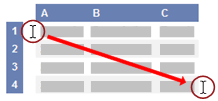Insert the current date and time in a cell
Important notice for users of Office 2003 To continue receiving security updates for Office, make sure you're running Office 2003 Service Pack 3 (SP3). The support for Office 2003 ends April 8, 2014. If you're running Office 2003 after support ends, to receive all important security updates for Office, you need to upgrade to a later version such as Office 365 or Office 2013. For more information, see Support is ending for Office 2003.
Let's say that you want to easily enter the current date and time while making a time log of activities. Or perhaps you want to display the current date and time automatically in a cell every time formulas are recalculated. There are several ways to insert the current date and time in a cell.
What do you want to do?
Insert a static date or time
A static value in a worksheet is one that doesn't change when the worksheet is recalculated or opened. When you press a key combination such as CTRL+; to insert the current date in a cell, Excel "takes a snapshot" of the current date and then inserts the date in the cell. That cell's value doesn't change, so it's considered static.
-
On a worksheet, select the cell into which you want to insert the current date or time.
-
Do one of the following:
-
To insert the current date, press CTRL+; (semi-colon).
-
To insert the current time, press CTRL+SHIFT+; (semi-colon).
-
To insert the current date and time, press CTRL+; (semi-colon), then press SPACE, and then press CTRL+SHIFT+; (semi-colon).
-
Insert a date or time whose value is updated
A date or time that updates when the worksheet is recalculated or the workbook is opened is considered "dynamic" instead of static. In a worksheet, the most common way to return a dynamic date or time in a cell is by using a worksheet function.
To insert the current date or time so that it is updatable, use the TODAY and NOW functions, as shown in the following example.
Example
The example may be easier to understand if you copy it to a blank worksheet.
How do I copy an example?
-
Select the example in this article. If you are copying the example in Excel Web App, copy and paste one cell at a time.Important Do not select the row or column headers.

Selecting an example from Help
-
Press CTRL+C.
-
Create a blank workbook or worksheet.
-
In the worksheet, select cell A1, and press CTRL+V. If you are working in Excel Web App, repeat copying and pasting for each cell in the example.
-
Important For the example to work properly, you must paste it into cell A1 of the worksheet.
-
To switch between viewing the results and viewing the formulas that return the results, press CTRL+` (grave accent), or on the Formulas tab, in the Formula Auditing group, click the Show Formulas button.
-
After you copy the example to a blank worksheet, you can adapt it to suit your needs.
|
|
Note: The results of the TODAY and NOW functions change only when the worksheet is calculated or when a macro that contains the function is run. Cells that contain these functions are not updated continuously. The date and time that are used are taken from the computer's system clock.
For more information about how to use these functions, see TODAY function and NOW function.
No comments:
Post a Comment